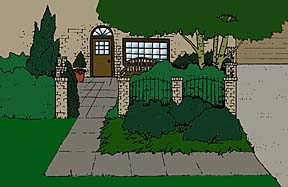Diagram and place space needs. Again, tape tracing paper over your plot plan and go back to your list of needs from step two. Place needs and activities where they can serve best and provide enough space for each need. (For example: and outdoor living area should be of sufficient size for the use it will receive.) Rather than decide upon the shape of a lawn, terrace or parking area at the beginning, let these forms develop from and reflect the needs listed in the beginning.
The following areas are frequently found in the home landscape. Develop each according to your family’s needs and priorities. Remember to take in to consideration…
- Soil requirements
- Practical turf areas
- Appropriate plant selection
- Efficient irrigation
- Maintenance Requirements
Work or Service Area

The work or service area can be convenient, orderly and attractive. Lawnmowers, wheelbarrows, tools, insecticides and fertilizers all need to be stored in a dry convenient location. If tool and equipment space is not already provided, plan for one. Since many service areas are most convenient when adjacent to the garage or carport, consider adding your storage area to an existing wall.
Garbage storage and clotheslines should be near the kitchen and laundry rooms. Allow at least four feet around the clotheslines to keep clothes from rubbing against fences, plants and walls. If only used occasionally, retractable or folding clotheslines may be the most practical.
Service areas can also contain a compost pile or space for cutting flowers and vegetables.
Consider screening the service area from view with either structures or plants to make it an attractive as well as functional part of the landscape.
Recreation or Active Sports Area

Features such as a swimming pool, shuffle board and tennis courts require considerable space and investment. A tennis court is normally 120 x 60 feet and a badminton court is 22 x 44 feet; swimming pools vary in size.
If some of these facilities are on your list of needs but not practical for immediate installation, you may consider leaving open turf areas that can be used for badminton, other games and play.
Outdoor Living and Entertaining Areas

Terraces and patios are an integral part of many Texas homes and should be located, if possible, where they will receive summer breezes and afternoon shade. If sun is a problem, add trees or overhead shading structures.
Outdoor living areas are usually adjacent to living areas of the house where they can easily be served and seen from inside. With the cost of interior floor space at an all-time high, outdoor living areas can economically add entertaining and living space. Even when not in use, well-planned, attractive decks and terraces adjacent to the house give a feeling of added space to interior rooms. Attractive, long-lasting outdoor furniture and accessories (such as water features, sculpture and container plants) can be useful and enrich outdoor living areas.
Some families have several outdoor living areas. Small terraces adjacent to bedrooms, bath areas and dining rooms are becoming more popular. A terrace may be placed away from the home to take advantage of a striking view, good breezes or the shade of an unusually beautiful tree.
Public and Entrance Areas

A large front yard is often a questionable use of land and resources. The parklike expanses found in some of our older subdivisions are pleasant but of little practical value. If your lot is small and building codes allow, consider developing the entrance area as a courtyard providing more use area for the family. If street parking is a problem use part of this area for off-street parking. Parking and enclosed front courts can be both attractive and functional.
Provide shade where it will most benefit your home’s energy conservation. Keep plantings simple with shrub masses, groundcovers and flowering trees used to serve real purposes.
Build walks and drives well and have them as direct and convenient as possible. Walks should be a minimum of 3 1/2 feet and preferably 4 feet wide. Provide a larger paved area at the entrance, if possible, since people tend to congregate there.
A few container plants, small flowering trees or specimen shrubs help to make the home’s entrance a focal point. Other features which focalize the entrance include architectural accessories such as attractive light fixtures, street numbers and front doors.
Children’s Play Area

Locate the play area where someone inside the house can easily see it. A sand pile and swing sets are popular as well as paved areas for riding toys, play houses and tree houses. Keep the designs simple and easy to maintain and consider how the area might be used after the children are grown.


